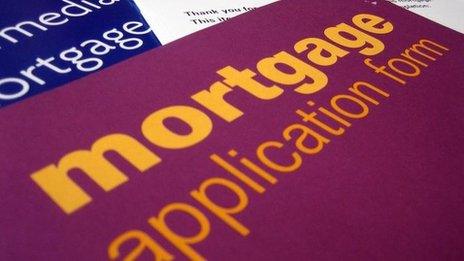Housing: Recovery or boom?
- Published
- comments

Figures from the Bank of England show there were 71,638 mortgage approvals for house purchases in December, a smallish 1.1% rise on the month but 29% more than a year earlier.
And the value of mortgages approved rose 8.8% to £12.4bn compared with November - and versus a year ago, the rise was an impressive 53%.
So, banks are definitely lending more, and we appear to have regained our appetite for house purchases.
The Chancellor's and Bank of England's assorted schemes for encouraging the banks to lend more - Funding for Lending and the two versions of Help to Buy - are having an impact.
And with housing construction up sharply, and purchases of consumer durables and housing-related financial services also on the up, this jump in the market is making an important contribution to the economic recovery.
But is there cause to fear that a dangerous and unstoppable boom is in the making?
House prices are rising sharply: according to the Nationwide, the price of a typical home this month was almost 9% higher than a year ago, and there have been 13 successive monthly price rises.
And what may be a concern is that these rises are taking place when the ratio of house prices to earnings remains well above the long-term average.
The most vulnerable group of purchasers is probably first-time buyers. And, according to the Nationwide, a typical first-time buyer home costs 4.6 times average earnings, compared with a 20-year average of 3.6 (although below the 2007 boom-year peak of 5.4).
Hardship
The worry would be that first time buyers - and others - are taking on huge debts just as we enter a cycle of rising interest rates after years of almost free money (although the Governor of the Bank of England says he is confident that when the price of money rises, it will be to an interest rate well below the norms of the '90s and the early years of this century).
So, apart from the potential for individual hardship if the affordability of mortgages becomes more challenging, are there risks to financial stability from what's going on?
Not yet.
Remember that the high loan-to-value mortgages are being guaranteed by the Treasury, under the two help-to-buy schemes. So if there are loan losses, the bulk of these losses will fall on taxpayers (yuk, perhaps).
More germanely, for all the recovery in mortgage lending, it remains much lower than in the boom years.
So December's £12.4bn of mortgage approvals compares with a peak of £17.9bn in November 2006 and with monthly mortgage promises of around £16bn on average in the two years before a vital course of finance for banks disappeared in August 2007 with the immolation of the market for mortgage-backed bonds.
Changed structure
As for the number of mortgage approvals, they remain massively less than what was typical in the 15 years before the crash.
From 1993 to 2003, monthly mortgage approvals were always in the range of 80,000 a month to 125,000 a month, well above the numbers provided today.
And in the 25 months before the market died, average monthly approvals were 116,000, 62% greater than in December.
All that said, the structure of the housing market has changed a bit: there are proportionately more cash buyers.
So, according to HMRC, there were 108,000 house purchases in December, almost 40,000 more than the number of mortgage approvals.
Which means that the risk of future house-price falls may rest more with people than with banks than in previous cycles. Which, many would say, is probably how it should be.